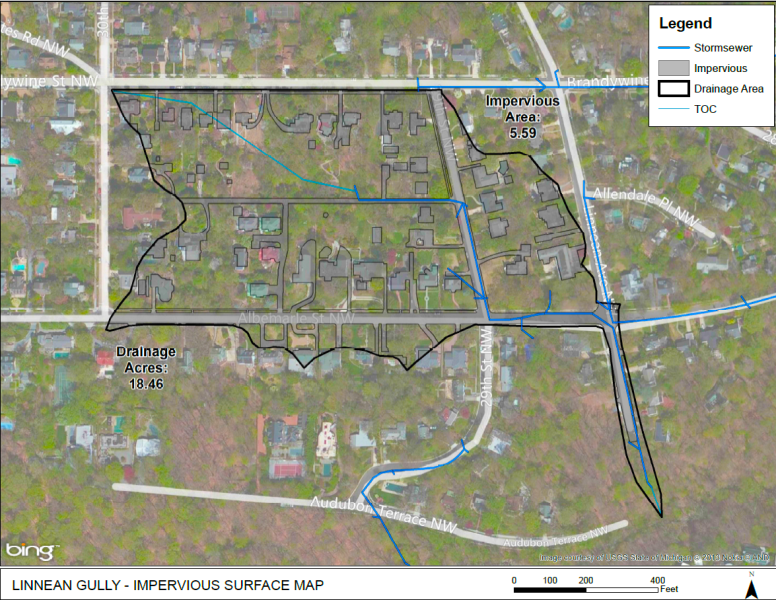<< Back to Stream and Habitat Restoration main page
Linnean Outfall and Gully Restoration
This restoration helped to prevent erosion, which will reduce nutrient and sediment pollution entering Soapstone Creek, Rock Creek, the Potomac River, and the Chesapeake Bay.
Project Location: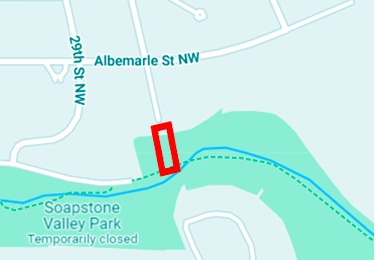
The Linnean Outfall and Gully restoration site is located in the Forest Hills neighborhood in Northwest Washington, DC. The project extends from a dead end on Linnean Avenue NW, south to Soapstone Creek in Soapstone Valley Park.
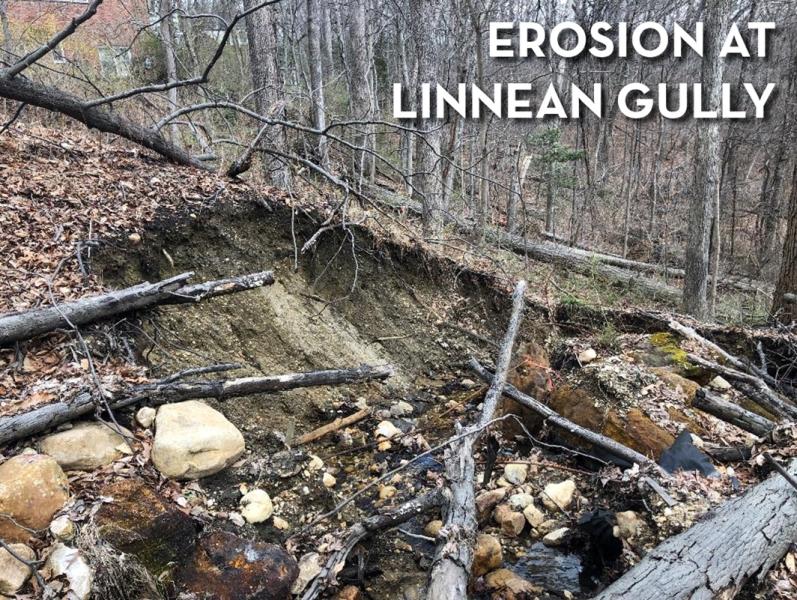 Project Overview:
Project Overview:
Stormwater flowing from the Forest Hills neighborhood caused severe erosion within the 200 ft gully that ran downslope from the stormwater outfall near the end of Linnean Avenue NW to Soapstone Creek. The stormflow destabilized the banks, degraded water quality, and undermined nearby trees. In addition, invasive plant species dominated the project area, inhibiting the growth of native plant species needed for a healthy ecosystem.
The restoration established a new stable channel by installing several cascades and pools to contain stormflows and slow the water before entering Soapstone Creek. 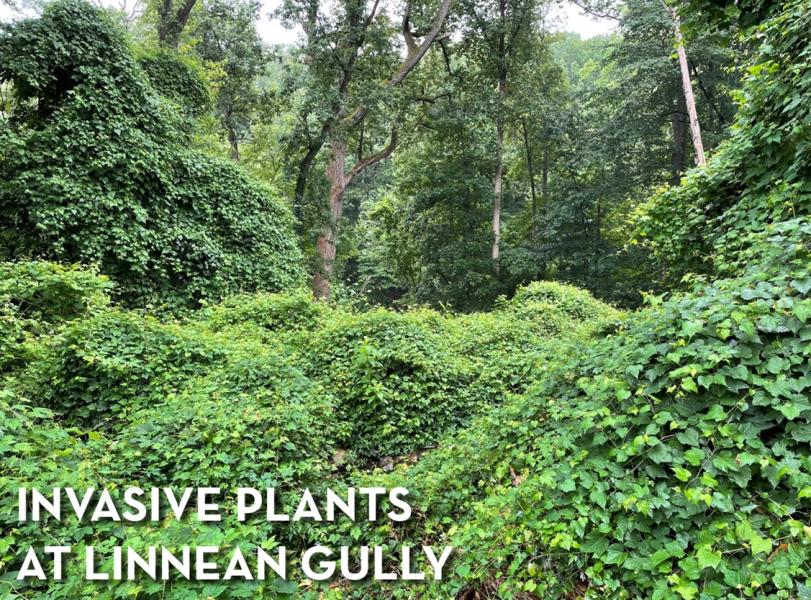 The project reduced erosion in the gully, and Chesapeake Bay Program protocols estimate that the restoration will prevent 172 lbs of Total Nitrogen, 28 lbs of Total Phosphorus, and over 85 tons of suspended sediment from entering the watershed each year! Plans also included installing 168 shrubs and at least 60 new native trees to help restore a healthy riparian forest.
The project reduced erosion in the gully, and Chesapeake Bay Program protocols estimate that the restoration will prevent 172 lbs of Total Nitrogen, 28 lbs of Total Phosphorus, and over 85 tons of suspended sediment from entering the watershed each year! Plans also included installing 168 shrubs and at least 60 new native trees to help restore a healthy riparian forest.
For a more in-depth review of the project goals, please read the project Final Design Report.
Project Partners:
The restoration project is located on property owned by the District Department of Transportation (DDOT) and designated as Right-of-Way. Since the DDOT Right-of-Way is surrounded by Soapstone Valley Park, which is operated by the National Park Service (NPS), DOEE coordinated with NPS to ensure designs would minimize impacts on the park and blend into the natural landscape. The project was also designed to align with the asset protection planned and constructed by DC Water along Soapstone Valley as a part of the Soapstone Valley Park Sewer Rehabilitation Project.
Funding for the project was provided by the EPA, through the District of Columbia’s Clean Water Construction Grant Program.
Project Goals:
- Reduce streambank erosion and channel bed incision to provide long-term stream stability and downstream water quality benefits.
- Remove invasive plant species within the project area
- Reduce stormwater volume and velocity entering the stream channel
- Improve in-stream and riparian habitat conditions
- Enhance tree canopy by protecting existing trees and planting new native trees
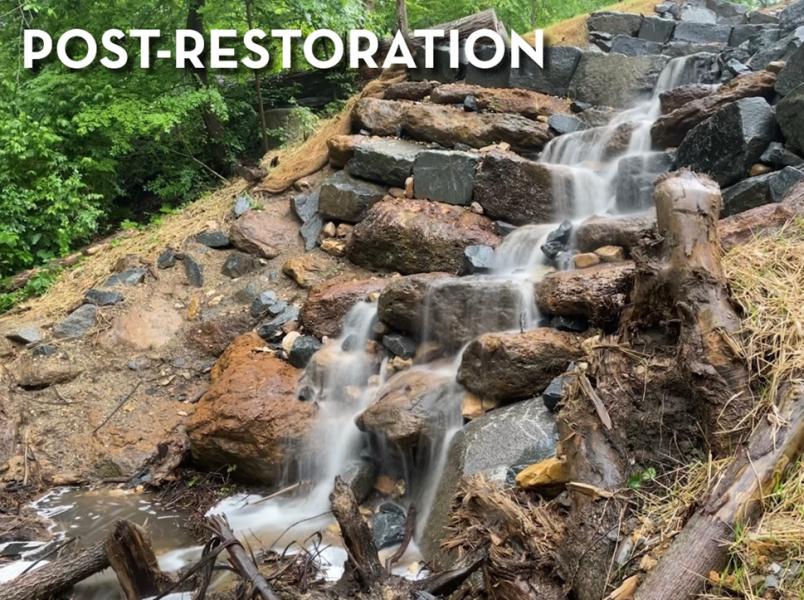 Project Status:
Project Status:
A Request for Proposals (RFP) was released in 2023 to select a contractor to conduct the design and construction of the restoration project. In February of 2024, DOEE awarded the design-build contract for this project to Biohabitats, Inc. Throughout 2024 DOEE worked with Biohabitats, DDOT, the National Park Service, and the community to produce and review designs for the project. See the “Community Presentations” section below for more information on the latest meetings. Construction for the project began in March of 2025 and initial plantings were installed in May of 2025. Additional plantings and invasive plant removal will continue as the restoration becomes established over the next several years.
Project Timeline:
- Design and Construction Award – Contractor selection completed February 2024
- Design Phase and Community Meetings – February 2024 to February 2025
- Initial Construction Phase – February 2025 to May 2025
- Project Maintenance and Invasive Species Removal – May 2025 to February 2027
Community Involvement:
Residential property owners in the project drainage area (see map below) are encouraged to learn more about the RiverSmart Homes program and how you can help reduce stormwater pollution. RiverSmart Homes offers incentives to residents who install practices that capture stormwater runoff such as rain barrels, shade trees, and raingardens. Make your home "RiverSmart" and be part of the solution to reduce pollution and erosion in Soapstone Stream and Rock Creek! For more information, please visit RiverSmart Homes.
Community Presentations:
- Linnean Gully Restoration Community Presentation 7-15-25
- Video: Watch Linnean Gully Restoration Community Presentation 7-15-25
- Video: Watch Linnean Gully Restoration Community Presentation 1-14-25
- Linnean Gully Community Presentation 1-14-25
-
Video: Watch Linnean Gully Restoration Community Presentation 11-21-24
- View Meeting Flyer -
Linnean Gully Restoration Community Presentation 11-21-24
- View Meeting Flyer - Linnean Gully Restoration – Community Presentation 9-17-24
- Video: Watch Linnean Gully Restoration Community Presentation 9-17-2024
- Linnean Gully Restoration – Community Presentation 7-16-24
Project Documents:
- Linnean Gully Final Design Plans
- Linnean Gully Final Design Report with Appendices
- Linnean Gully Semi-Final Design Plans
- Linnean Gully Semi-Final Design Report with Appendices
- Linnean Gully Concept Design Plans
- Linnean Gully Concept Design Report with Appendices
Contact:
For questions or more information, please contact Matt English at [email protected] or (202) 308-0453.
